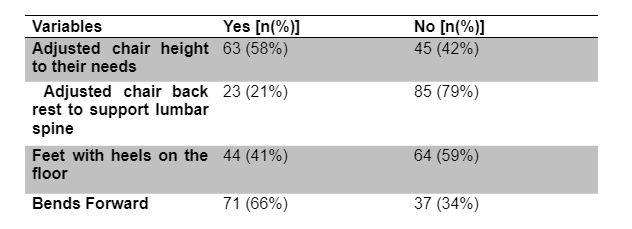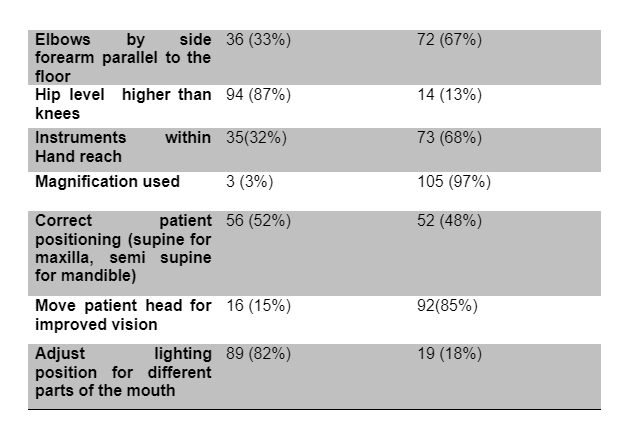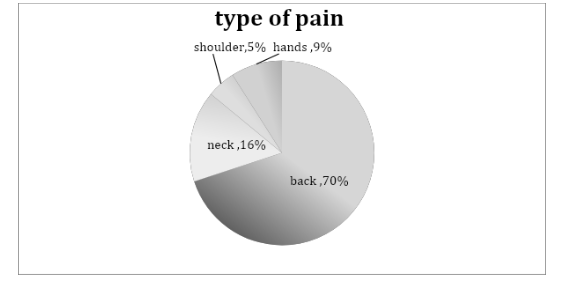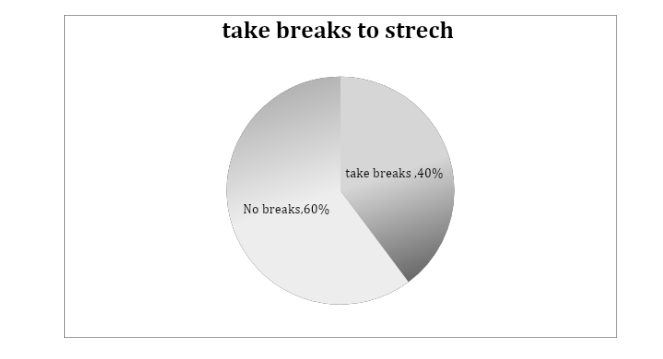Work-Related Musculoskeletal Disorders in Dentistry: Causes, Impact, and Prevention Strategies
Musculoskeletal disorders (MSDs) are disorders that affect the musculoskeletal system of the body, such as the muscles, joints, tendons, ligaments, bones and nerves not directly resulted by sudden events e.g. falls (World health organization). It is a major ill health condition in Great Britain and across the EU (reference).These disorders can be considered to be work-related when the ergonomics of the working environment affects the performance of the worker in a way that it can place them at risk of acquiring such disorders (World health organization,1985). An estimation of 8.8 million working days lost per worker due to WMSDs in the UK (Gov,2017).Work-related MSDs can develop over a period of time and can be aggravated by the presence of risk factors. According to Khan and Chew (2013), causes of work-related MSDs have been shown to be multifactorial. These risk factors are common in dentistry particularly by sustaining a prolonged improper positions and repeated movements (Khan and Chew, 2013).The nature of the dental profession requires the dentists to maintain a static working position and a repetitive motions under high concentration with precise hand movements whilst treating patients, for which, they are at increased risk of developing WMSDs. If you are facing challenges in addressing these issues, seeking healthcare dissertation help can be very helpful as it gives valuable insights and support in finding effective solutions.

A systematic review carried by Hayes et al. (2009) revealed that the prevalence of work-related MSDs amongst dental health care personnel is significant, ranging between 64% and 93%, with the back and neck being the most commonly cited regions. The conditions can be mild initially, however, if preventative measures are not implemented earlier it may get severe to debilitating later in life. Sakzewski and Naser-ud-Din (2014) reported that MSDs increased the number of clinician seeking medical services, asking for a sick leave and contributed to the early retirements thus affecting the dentists’ quality of life .It has been reported that work-related MSDs contributes to early retirement amongst qualified dentists (Madaan and Chaudhari,2013). Consequently, it affects the economy and productivity of the dental practice.
Therefore, the issue of MSDs should be taken into consideration due to the considerable burden it poses to the dental profession. Dental health care personnel are highly susceptible to MSDs regardless of years of dental expertise being demonstrated by some studies (Laggat and Smith, 2006; Rising et al., 2005), Correspondingly, this advocates that even dental students can show early signs and symptoms of work-related musculoskeletal pain during their clinical practice as undergraduate students, which was demonstrated by studies carried out world-wide in countries such as Malaysia, Iran, Australia, USA, Italy, Turkey, India and Brazil. According to Rising et al. (2005), 70% of undergraduate dental students complained from back, shoulder and neck pain at the beginning of their clinical training in dental schools, which is coincident with studies carried out by Vinaya Kumar et al. (2014) and Diaz-Caballero et al. (2010). Additionally, according to Ng et al. (2016) the majority of dental schools educates their students about the correct posture in a very early stage and is not reinforced as they progress.
Therefore preventive programmes should be promoted and reinforced in the dental curriculum to prevent the developing of MSDs during their educational and future professional life (Gupta ,2013).
Many studies have focused on the prevalence of work-related MSDs on qualified dentists and revealed that it can commence well before the beginning of a professional career. Nevertheless, only few studies in the literature addressed the prevalence of the work-related musculoskeletal pain in undergraduate dental students.
The aim of the present study is to determine the prevalence and the possible risk factors of Work-related MSDs amongst senior dental students at Leeds Dental Institute and to highlight the importance of postural awareness to avoid jeopardizing the health of dental students and in turn improving the quality of their performance.
Thus the objective of this study is to determine the presence of musculoskeletal symptoms in senior dental students during or after clinics and to carry out a postural assessment to evaluate their posture and the working environment
Materials and Methods:
The study design is quantitative descriptive study using a cross-sectional approach. The study examined the prevalence of WMSDs amongst 4th and 5th year’s dental students at Leeds Dental Institute through a questionnaire. In addition, the study also conducted a postural assessment through an observational checklist to investigate the possible risk factors that may contribute to MSDs
The study was conducted on November 2016 over 4 week period. Approval to carry this study was gained on October 2016 from The Dental Ethical Research Committee at Leeds Dental Institute
A cross-sectional approach was chosen as this was considered to be the most appropriate method to answer the research question as it allows the assessment of multiple factors at single point in time and it’s also useful in yielding prevalence estimates.
Students’ restorative clinical sessions were collected from the timetabling department prior conducting the study. Restorative Clinical sessions were divided randomly on all 5 examiners depending on their availability. All 5 examiners attended a Manual Handling and Ergonomics course with DBG and obtained a certificate in ergonomics to be able to spot student’s postural errors and to assess the working environment.
Exclusion criteria are 1st, 2nd and 3rd year dental students, senior students with pre-existing musculoskeletal disorders those performing prosthetic treatments and oral hygiene instructions.
A trial observation and checklist completion took place with all 5 examiners on 6 participants from the 3rd year dental students to standardized data collection ensuring inter-examiner reliability. Each student was observed by two examiners ensuring validity .Additionally, the questionnaires were also pre-tested by the students where feedback obtained and adjustments were made accordingly.
Prior to data collection, permission gained from the tutors supervising the students on clinic. Verbal and written consent gained from participating students on a voluntary basis and they were assured that their contribution would be confidential and anonymous. However, the main aim of the study was withheld to introduce single blinding as it may affect the study results. Students were informed about the aim of study fully after the observations were completed and the questionnaires were collected from all students on the day. Patients were given an information sheet with plain-language statement explaining the study and consent was gained prior to commencement of the study.
The researcher recruited as many participants as possible .Students were observed for 10 minutes using a timer during their restorative clinics without interfering with their treatments. A standardized observational checklist was used which is composed of 3 variables: an assessment of operator chair, the operator posture and patient positioning errors.
A self-administered questionnaire comprising questions about demographics, treatments carried out, musculoskeletal pain, pain managements and level of fitness were distributed amongst the participants at the start of their clinical sessions and were asked to fill them at the end of their sessions .The questionnaire also included some misleading questions to divert the participants attention towards the aim of the study. .It is in a tick-box format and took less than 5 minutes to complete. Questionnaire was collected at the end of the sessions. For each participant both the observational checklist and the questionnaire were numbered correspondingly ensuring anonymity.
Data were collected on spread sheets and entered into a Statistical Package for Social Sciences (SPSS) and analyzed using chi-square test to identify any association between two independent variables . Statistical significance was accepted for P < 0.05.
Results:
A total of 116 senior dental students participated in the study. However, 8 participants were excluded due to pre-existing musculoskeletal disorders. The demographics of students enrolled in this study are shown in table 1.The age range was from 20-30 years old.

According to the observational checklist were divided included 3 variables
Assessment of the operator chair:
79 % of the participants’ backs were not supported, while 21 % used the backrest to support their back throughout the 10 minutes period of observation (table 2). However, no significant association was found between back support and musculoskeletal pain (P=0.867, p>0.05). Additionally 42% of them had the wrong chair height which prevented them to sustain a comfortable posture whilst working.
Assessment of the operator posture:
66 % of dental students were bending forward and 68% of participants’ instruments were not within hand reach (table 2). Nevertheless, no significant association reported between leaning forward and musculoskeletal pain (P=0.146,p>0.05).In addition, 59% of dental students’ feet were not fully on the ground.
Assessment of the patients positioning:
Eighty-Five percent of the dental students had the wrong patients’ head positioning when carrying treatments either in the maxilla or mandible .The majority of them (82%) had the correct light positioning(table 2)


Presence of pain and areas affected:
70% of the participants reported muscular pain whilst or after treating patients and the majority of them were females. Students who specified the areas affected by pain reported that the back was the most commonly affected (70% of students) followed by pain in the neck (16%), hands (9%) and the least affected being the shoulders (5%)(Graph 1) .

Pain management:
Despite high percentages of dental students had muscular pain, the majority of them managed their pain by resting, while twenty-six percent of the participants did nothing (Graph 2).

Magnifications:
Only 3 % of the participants used dental loupes. However, there was no statistical significance between the use of dental loupes and musculoskeletal pain (P=0.916,p>0.05 ).
Exercises:
A majority of the students (74%) partake in some sport activities mainly working out at the gym while 26% are not involved in any sports activities. No statistical significant was found between exercising and musculoskeletal pain (P =0.832, p>0.05)
Breaks:
Although, the majority of the study participants reported muscular pain whilst or after working, a large number did not undertake any stretching exercise when they had breaks which could have lessen the symptoms (Graph 3). However no significant association reported between stretch breaks and musculoskeletal pain (P=0.225,p>0.05)

Discussion
This cross sectional study was carried out to evaluate the prevalence and the possible risk factors of Work-related MSDs in a sample of senior dental students. This study supports and underlines the concern raised by other studies regarding the susceptibility of dental students to the early symptoms of MSDs.
In this study, the reported prevalence of work-related muscular pain in 70 % of dental students is near to the results of with other studies. According to Diaz-Caballero (2010), 80% of dental student in South America reported muscular pain after treating patients. Moreover, two studies carried out in India stated that the majority of dental students complained from muscular pain ranging from 81-91% (Vinaya Kumar et al. 2014 and Madaan ,2013).This is also in line with a study carried out by Ng (2016), which reported that 85% of Australian dental students suffered from pain after working in a dental setting. In addition, a recent study carried out in the United Kingdom reported that 79% of undergraduate dental students experienced musculoskeletal pain (Vujay and Ide 2016 ).
This study revealed that lower back pain was the most commonly reported pain followed by neck pain. This is consistent with a number of studies carried out by (Andresson 1993), (Vujay and Ide 2016), (Finsen, 1998), (Ratzon, 2000), (Szymanska, 2002). Norkin (1992) stated that these regions are susceptible to damage more easily and can arise through inadequate work breaks.
Moreover, 79 % of the participants had unsupported back whilst working and 66 % of them were bending forward to obtain a better vision of the oral cavity, this may refer to the high prevalence of muscular pain reported. Improper positioning with inadequate back support or chair adjustability when maintained for a prolonged period of time results in muscular fatigue and eventually backache (Valachi and Valachi , 2003., Daniel et al ,2008 Johanning ,1998).

It is common practice of the dental clinician to remain in a static position and use the same muscles repeatedly whilst working which results in muscle fatigue. According to Sjognard (1985) damaged muscles require a rest period to repair itself. Consequently, inadequate stretch breaks have been shown to increase the risk of acquiring Work-related MSDs (Reference ).Thus, rest periods accompanied by stretches are important in relieving the muscle tension limiting the development of MSDs (Finsen 1998). In this study 60% of undergraduate dental students did not undertake any chair side stretches during breaks .This emphasize the benefits of frequent stretch breaks as a preventative technique to be adopted in the dental field.
Further research done by epidemiological findings have proven the state of having a healthy spine and a back posture in a full healthy state is in result from an individual maintaining high fitness levels and body strength (Finsen 1998 ). Fitness levels and MSDs have direct and interfered relationships amongst each other (Gupta et al., 2013). According to the words of “Vishwas Madaan and Amit Chaudhari”, dental students who lack average or high fitness level and or core/body strength are most likely to develop MSD’s.
The development of MSD’s can also be caused by the inflexibility of the human body and no strength of the core. Having a strong core that are flexible and well stretched is a high factor of preventing muscle injuries and pain (Gupta et al., 2013). In addition, exercise done in the correct form and focused on the shoulder, neck and back regions with certain workouts can and will improve the function and mobility of the human back and prevents work-related musculoskeletal injuries(Kumar,Rathan ,2014?). According to a particular study from “Peros et al.34”, it was mentioned that a physical education and fitness program introduced into the dental curriculum that includes an hour and a half of cardiovascular exercises per week had a positive impact in reducing back pain amongst dental students in Croatia. These findings were consistent with other studies ( Hayes et al,2009),(Movahhed,et al.2013)
Moreover, according to Kumar, Rathan, (2014) it is very important to stretch muscles that are stiff and tight along with strengthening core muscles as previously stated to prevent MSDs inline with other study carried out by chiropractor, Rishi Loatey(year). The change of certain lifestyle habits or traits that are bad can prevent such disorders.
Although in the dental school dental students are exposed to a small number of patients, when there are qualified they are exposed to large number of patients. Adopting these habits during their training have deleterious effects in the future.
Within the Leeds Dental Institute, it has been reported that only 3% of the dental students use “Dental Loupes” during their clinical work period. This could be due to its high and expensive cost within the region. So it results to dental loupes not having a big demand by individuals. Dental loupes are positively affected to the people because it enhances visualizations and maintains great ergonomic postures (UBC, 2008).The level of diagnostic abilities and motor controls are highly maintained due to excellent systems that result to dental practitioners(Rucker, 1998).
Women have a higher rate of musculoskeletal disorders than men do. This is in result to the lower muscle volumes and fitness levels or strength of women and female hormones in comparison to men and male hormones (Rising et al ,2005)(Ref). The average level of pain in women are more than men as stated by Linfors et al. (2006) and according to the study of Diaz-Caballero et al. (2010) it has been reported the percentage of average pain within female students is 83% while with men it is 41%. These results are consistent with this study in which the majority (70%) of those who reported pain was females. Contrary to this, two studies have found no significant correlation between gender and muscular pain (Movahheld ,2013 and Melis et al,2004).This may be due to unequal sample size between females and males (74 vs. 34).Therefore , longitudinal studies may be suggested for a better insight in this regard.
Sixty-Eight percent of participants’ instruments were not within hand reach which involved them twisting and excessively loading the spine to reach for equipment’s .As a consequence there is increased risk of developing MSDs. Dental equipment’s should be easily accessible with less effort. According to Nagar Shipra, 2015, items used regularly should be placed in a “comfortable distance”.
On the other hand, other studies have mentioned other contributing risk factors, such as stress. According to Mavahheld (2014) high stress level of dental students increases pain severity. This is also supported by (Feng et al.,2014) a systematic review carried by Elani (2014 ), which demonstrated that dental students are likely to be more stressed than other undergraduates mainly due to performance pressure which directly affect their physical health. Moreover, according to Warren, N(year) demonstrated that psychosocial problems can also contribute in the development of musculoskeletal disorders in dental healthcare setting. Other risk factor could be due to genetic predisposition (Biller,1946 ).
Besides, it has been shown that individual’s heights and weights may also contribute to the development of musculoskeletal disorders although it was not accounted for in this study. According to Mavahheld (2014), the prevalence of back pain increases with increased BMI. This coincides with results found from meta-analysis by Shiri et al (year)which revealed a strong association between overweight individuals and backache . (This explanation of this can be through the mechanical load’s increase on the spine of the individuals who are obese because of the force of higher comprehension or increase in shear on the structures of lumbar spine in the time of various activities. The study to be more certain that aims for the comparison of the MSDs in the underweight, normal, and overweight dental students). In addition, height is positively associated with muscular injury affecting more commonly the neck (Bartleson,year).
With regards to the limitation and the strength of the current study, in ensuring the study’s validity that had been pre-tested on the students studying in the 3rd year by all five researchers. Additionally, the collected data has been tested and recorded by five examiners twice in minimizing information bias and errors. In spite of attempting the achievement of the reliability of the inter examiner with the observational assessment carried out by the two examiners, the existence of the variability remains. The limitation that is primary in this study is that the correct postural requirements and the knowledge regarding the ergonomics have not been asked to the students.
Moreover, the incapability of correlating the observed variables, such as, operator chair, operator posture and the patients that positions to the musculoskeletal pain are what the students experienced. Furthermore, the observation carried out for ten minutes and the sample may not be enough as representative. The achievement of the single blinding could not have happened because the examiners had to seek consent and being standing in place where the participants had the awareness of it could have changed the results. Moreover, there was no measurement of the severity of the pain. Thus, the study’s outcome can experience difficulty in measuring. The benefits of the future studies can be accrued from the inclusion of weight and height of the participants, and the questions more specific regarding the ergonomics and severity awareness, and the sample size being larger representing the general population.
Conclusion;
The prevalence of work-related musculoskeletal disorders was high amongst undergraduate dental students at Leeds dental institute. The most common affected regions were back and neck pain. Despite the limitation of the present study, these results are coincidence with previous studies carried out on dentist and dental students In order to prevent such injuries and or be at high risk of negative effects, it is highly suggested that ergonomic advices and courses should be offered and introduced to students working in this field of a working career and in the beginning of their education as well as raising awareness about its importance and the potential risk factors that contributes to the development of MSDs. Moreover, students should understand the importance of regular breaks and physical exercises and they should pay particular attention to their posture in relation to the patient decreasing unnecessary tension to their musculoskeletal system. Dental loupes should be encouraged to use due to its positive effects in maintain optimal posture.
Continue your exploration of What explains the link between childhood with our related content.
- 24/7 Customer Support
- 100% Customer Satisfaction
- No Privacy Violation
- Quick Services
- Subject Experts



